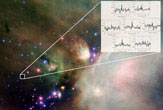Rare Space Molecules Point Toward Star Nurseries

Astronomers have mapped a rare type of molecule in cosmic clouds that could reveal secrets about how stars form.
Stars form in clouds of dust and gas. Before the birth of the star, these clouds are dense and extremely cold, causing most of the gaseous molecules to freeze on the surface of solid dust grains, similarly to the condensation of water vapor onto a cold mirror.
This condensation process happens to almost all of the gas molecules, leaving only a few still in gaseous form. These conditions leave room for the development of a peculiar chemistry between the remaining gaseous molecules, leading to the formation of the rare molecular species H2D+ and D2H+, built from the hydrogen atom (H) and its heavier variety deuterium (D).
These peculiar molecules have been the target of many observational searches in the last decade, but because they are formed in such small quantities, they are hard to observe.
Now a new study using the Atacama Pathfinder Experiment (APEX), observing from a pristine location in the Chilean desert with a special instrument called CHAMP+, has mapped the distribution of the molecules in the core of the Rho Ophiuchi cloud, a star-forming region about 400 light years from Earth. [Photo of the star-forming cloud]
These scarce molecules have long been an observational goal of astronomers.
"This is because their emission can help astronomers to understand the extreme physical conditions in stellar cocoons," said Bérengère Parise of Germany's Max-Planck-Institut für Radioastronomie, who is head of the Emmy Noether research group. "Their study is essential for understanding the processes that lead to the formation of stars and their planetary systems."
Sign up for the Live Science daily newsletter now
Get the world’s most fascinating discoveries delivered straight to your inbox.
The observation of these peculiar molecules is also made difficult because they emit light with a very short wavelength. The wavelength of the emission, shorter than one millimeter and therefore referred to as "submillimeter light," lies in a frequency window where the earth atmosphere is transparent only under the best weather conditions.
These observations thus require the best submillimeter telescopes located at the best observing sites, joined with sensitive instruments that can detect these faint signals.
That helps explain why most observational searches for these molecules – especially the particularly hard to find D2H+ — have been unsuccessful. To date, there has been only one claimed detection with another submillimeter telescope, with an uncertain frequency calibration.
The new observation resulted in a surprising discovery: The molecule was not only detected in the coldest center of the core, as expected by the research team, but also in some of the side pixels, showing that the distribution of this molecule is extended, and not only confined to the innermost region of the core.
This finding is an important piece of information for understanding the peculiar chemistry taking place in the extreme environments from which stars form. It implies that the freezing of molecules on dust grains is extremely efficient, a result that the team will try to confirm by independent observations in the coming months.
"This is the definitive confirmation of the existence of this rare molecule in space," Parise said in a statement. "The information on its spatial distribution provided by the CHAMP+ observation opens the possibility to investigate in details the chemical and physical processes taking place during the early phases of star formation."
This article was provided by SPACE.com, a sister site of LiveScience.com.










